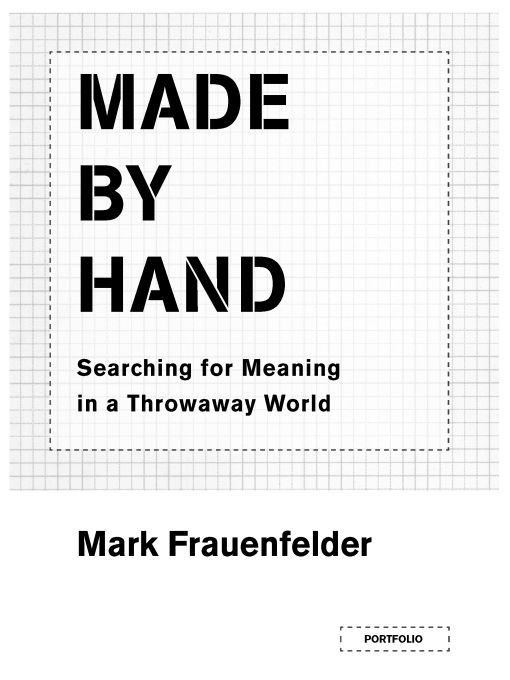
Made by Hand
Searching for Meaning in a Throwaway World
فرمت کتاب
ebook
تاریخ انتشار
2010
نویسنده
Mark Frauenfelderناشر
Penguin USA, Inc.شابک
9781101432969
کتاب های مرتبط
- اطلاعات
- نقد و بررسی
- دیدگاه کاربران
نقد و بررسی

April 12, 2010
In this overwrought ode to doing it yourself, Make
magazine editor Frauenfelder attempts to “forge a deeper connection and a more rewarding sense of involvement with the world” by making more of the things his family uses and eats. His DIY projects are varied—organic gardening, building a chicken coop, constructing cigar-box guitars, keeping bees, tutoring his daughter—and not uniformly successful: chickens get devoured by a coyote; the bees subsist on sugar-water handouts; his daughter fails the big math test. (Not to worry, he insists, since accepting mistakes is foundational to the DIY ethos.) Frauenfelder’s hand-making procedurals are engaging, but, for him, practicality takes a back seat to spirituality, to living authentically, to grokking “the Japanese concept of wabi sabi, the beauty found in an object’s imperfections.” He often presents DIY as a form of therapy: spoon-whittling isn’t about spoons, it’s about “the calming and focusing effect of spoon-whittling.” (And like most therapies, these projects often require lots of disposable income—a thousand dollars for a load of mulch!—and spare time.) People have hobbies because they are interesting and fun; by inflating hobbyism into a belief system, Frauenfelder doesn’t add much to their appeal.

April 15, 2010
An amateur craftsman is inspired to tackle a laundry list of obscure projects.
Hobbled by the dot.com bust, Frauenfelder and his wife began to think carefully about how to maximize their space and resources. A propitious if misguided move to a South Pacific island"paradise" proved short-lived, but their time there instilled a new perspective on working with their hands, the importance of down-time and how to utilize raw materials in new and beneficial ways. Frauenfelder's immensely popular gadget-centric blog (BoingBoing.net) garnered attention from a contemporary interested in launching a periodical focused on"how to make, modify, and repair things." Born in 2005 with Frauenfelder as its editor-in-chief, Make magazine highlighted enticing projects using"tested, step-by-step instructions." The author went a step further by incorporating DIY home-improvement concepts into their Southern California lifestyle and created a wish list of projects he hoped to accomplish. Frauenfelder wittily chronicles his varying degrees of success in making everything from fermented kombucha yogurt to a chicken coop. Replacing persistent Bermuda grass with mulch proved an exercise in patience, as did adventures in coffee, chickens and bee colonies, but the rewards were great after the author constructed several homemade multi-stringed guitars from cigar boxes, whittled wooden spoons and tutored his daughters. Throughout the narrative, a host of eclectic characters emerges, including 80-year-old Picasso lookalike Alfie;"Mister Jalopy," a secretive, brilliant tinkerer; a gay Tennessean who believes fermented foods keep his HIV infection in check; and two nonprofit organizers who assisted with the cultivation of the author's bountiful vegetable garden, one of his proudest achievements. Frauenfelder gained much self-confidence throughout his clunky experimentation, though he admits that along with everything else,"you have to live with the mistakes you make."
A utilitarian motivational booster for DIYers.
(COPYRIGHT (2010) KIRKUS REVIEWS/NIELSEN BUSINESS MEDIA, INC. ALL RIGHTS RESERVED.)

June 1, 2010
Editor in chief of "Make" magazine and cofounder of BoingBoing.net, Frauenfelder here chronicles a year of delving into do-it-yourself projects such as keeping chickens and bees, gardening, making cigar-box guitars, and customizing an espresso machine. With each project, he illustrates the importance of technology and community in the resurgence of DIY and sustainable living practices. That more technology inspires back-to-basics living may seem surprising, but it makes perfect sense. The web rapidly connects us with a vast variety of people and ideas, making it easy for the beginner (or experienced) DIYer to access expertise and instruction. When Frauenfelder had to build a new chicken coop, for example, he used Google SketchUp to create a design. The author makes frequent references to online sources and communities in finding help and follows up on many of these connections in person. VERDICT Frauenfelder offers an original perspective on the sustainable living and DIY movements, and this title should appeal to a tech-savvy audience.Meagan P. Storey, Virginia Wesleyan Coll., Norfolk
Copyright 2010 Library Journal, LLC Used with permission.

























دیدگاه کاربران